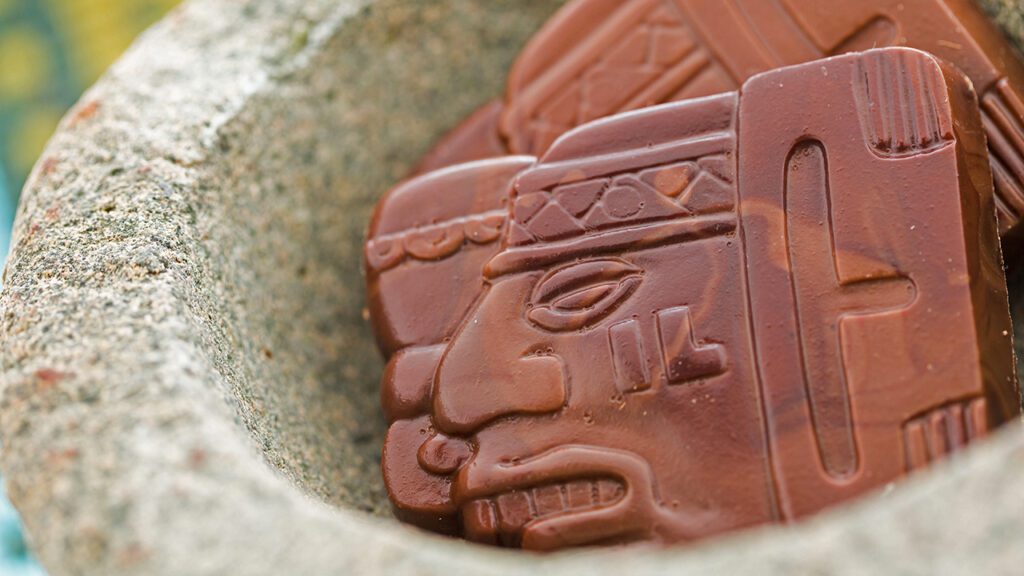One might hesitate on their last bite of KitKat if they’ve known that chocolate was of high value back in the Mayan times. With its use in the marketplace and as a tribute to their kings, it’s evident that the Mayan economy was partially dependent on their cacao supply.
Chocolate was a valuable form of currency back in ancient civilizations. Experts believe the lack of successfully grown cacao trees led to their high value in the Mayan periods.
The Ceremonial Olmec Cacao
KitKat, Cadbury, Mars, Toblerone, and more chocolate bars! If you were to possess all these goodies back in the Mayan Civilization, you would be one of the elites. Chocolate became a unique form of currency in the Mayan Civilization, as discovered by new research.
It’s unclear who started to make chocolate from cacao back in the day, but the earliest findings that depict chocolate having a high value were in the Olmec Civilization. Hayes Levis, a cultural arts creator in the National Museum of the American Indian, stated that old Olmec vessels dated back from 1500 B.C. indicated theobromine’s presence, a stimulant in chocolate.
The people from the Olmec Civilization used cacao as a ritual or ceremonial drink. Experts remain irresolute whether they used cacao beans or the pulps of the cacao pods. (Source: History)
The Mayan’s Revered Chocolate
The Mayan Civilization’s knowledge of cacao came from the teachings of the Olmec Civilization. The Central American Mayans were known for their frequent consumption of chocolate and the great value they placed on it. (Source: History)
David Friedel, Washington University’s anthropologist & Mayan expert, confirmed this statement, stating that it was unmistakably a currency because of its widespread prestige.
The ancient Mayans never used coins as money. Instead, like many early civilizations, they were thought to mostely barter trading items such as tobacco, maize, and clothing.
Joshua Rapp
Archaeologist Joanne Baron identifies the usual depiction of market barters and offerings to the Mayan King in her analysis, specifically existing researches on the Mayans and classic images from 250 C.E. to 900 C.E. rooted from the southern Mayan regions and Central America.
Within these various forms of art, the usage of chocolate became prevalent around the 8th Century C.E. period. During those times, chocolate became often used as a typical form of payment for goods and services. (Source: Science)
How Did Researchers Come Up With The Theory
Seen on a mural from the 7th century, painted on a pyramid wall close to the Guatemalan border, a man exchanges dough to a woman offering a bowl of foaming hot chocolate. Baron further explains that the usage of chocolate was in trading as opposed to the idea that it was a form of money.
Contrary to Joanne Baron’s statement, more than 180 findings of ceramics and murals from 691 C.E. to 900 C.E. depict that the usage of chocolate became similar to that of coins. Dried and fermented cacao beans stored in woven cloth bags labeled with the quantity were one of the most shown tributes or tax payments to the Mayan leaders.
Friedel suggests that the high value of cacao beans was because of the recurrent crop failure among cacao trees. Baron theorizes that Mayan leaders gathered cacao and woven cloths as tax, strengthening cacao payment as a valid form of currency. Excess of these was either used in the market or used as a palace worker salary. (Source: Science)
The use of cacao as a high-value currency became so abundant that individuals started to produce fake cacaos made of clay. Experts speculate that one of the reasons for the economic downfall of the Mayan Civilization was the disturbance in cacao supply. (Source: Open Culture)
